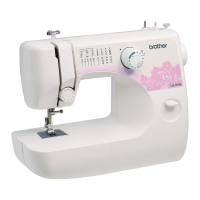
Do you have a question about the Brother LX-3125E and is the answer not in the manual?
| AC input voltage | 110 V |
|---|---|
| Power supply type | Electric |
| Free arm | Yes |
| Control type | Rotary |
| Sewing speed | 900 |
| Feed dog type | 6 point |
| Product color | White |
| Buttonhole type | 4 Step |
| Number of programs | 35 |
| Sewing machine functions | Sewing |
| Number of stitch patterns | 14 |
| Depth | 376.9 mm |
|---|---|
| Width | 156 mm |
| Height | 293.1 mm |
| Weight | 5987 g |
Addresses issues like incorrect needle insertion, loose clamp screw, or improper thread tension.
Covers problems with incorrect upper thread, tension set too high, or thread size mismatch with needle.
Focuses on issues like entangled lower thread in the shuttle or incorrect tension/threading.
Explains causes for loops, including incorrect tension settings or improper threading.
Details how tension, threading, or caught threads can cause fabric puckering.
Identifies reasons for skipped stitches, such as needle issues or incorrect threading.
Provides solutions for slow or noisy operation, often related to cleaning or lubrication.
Offers guidance on how to properly wind a bobbin and remove excess thread.
Dial to choose from 10 different stitch patterns for various sewing needs.
Screw used to ensure uniform stitching on both sides of a buttonhole.
Lever that guides the thread through the machine, essential for proper stitching.
Detachable flat bed for easier sewing of cuffs and sleeves, with built-in accessory storage.
Adjusts the tension of the upper thread to ensure balanced stitches.
Lever used to sew backward, typically for securing seams.
Component that holds the presser foot in place during sewing.
Screw used to attach and secure the presser foot.
The standard presser foot used for most sewing, including zigzag stitches.
Metal plate under the presser foot with a hole for the needle.
The part that holds the bobbin and interlocks with the upper thread.
Holds the bobbin and fits into the shuttle hook assembly.
Teeth that move the fabric under the presser foot.
The sharp point that pierces the fabric and carries the upper thread.
Screw that secures the needle in the needle clamp.
Cover that protects the shuttle hook and bobbin case area.
Port where the foot controller is plugged in to operate the machine.
Lever used to raise and lower the presser foot.
Switch to turn the machine's power and sewing light on or off.
Integrated handle for easy and efficient transporting of the sewing machine.
Guides thread during winding and normal sewing, includes pre-tension disc.
Built-in feature to easily cut excess thread after sewing.
Pin for holding the thread spool during sewing and bobbin winding.
Mechanism used to wind thread onto a bobbin.
Wheel used to manually control the needle's movement, especially for lower threading.
Lists common accessories like bobbins, needles, and light bulbs for replacement.
